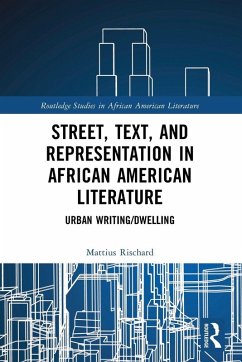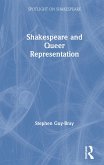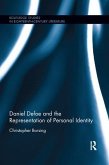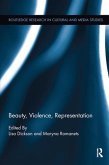Mattius Rischard
Street, Text, and Representation in African American Literature
Urban Writing/Dwelling
Mattius Rischard
Street, Text, and Representation in African American Literature
Urban Writing/Dwelling
- Broschiertes Buch
- Merkliste
- Auf die Merkliste
- Bewerten Bewerten
- Teilen
- Produkt teilen
- Produkterinnerung
- Produkterinnerung
Comprehensive and comparative, this volume investigates African American street novelists from the Chicago Black Renaissance and the semiotic strategies they employ in publication, consumption, and depiction of street life.
Andere Kunden interessierten sich auch für
![Addiction, Representation and the Experimental Novel, 1985-2015 Addiction, Representation and the Experimental Novel, 1985-2015]() Heath A. DiehlAddiction, Representation and the Experimental Novel, 1985-201544,99 €
Heath A. DiehlAddiction, Representation and the Experimental Novel, 1985-201544,99 €![Writing for the Street, Writing in the Garret Writing for the Street, Writing in the Garret]() Michael KearnsWriting for the Street, Writing in the Garret29,99 €
Michael KearnsWriting for the Street, Writing in the Garret29,99 €![Shakespeare and Queer Representation Shakespeare and Queer Representation]() Stephen Guy-BrayShakespeare and Queer Representation116,99 €
Stephen Guy-BrayShakespeare and Queer Representation116,99 €![Autism and Representation Autism and Representation]() Autism and Representation61,99 €
Autism and Representation61,99 €![Daniel Defoe and the Representation of Personal Identity Daniel Defoe and the Representation of Personal Identity]() Christopher BorsingDaniel Defoe and the Representation of Personal Identity59,99 €
Christopher BorsingDaniel Defoe and the Representation of Personal Identity59,99 €![Text, Theory, Space Text, Theory, Space]() Liz Gunner / Sarah Nuttall (eds.)Text, Theory, Space55,99 €
Liz Gunner / Sarah Nuttall (eds.)Text, Theory, Space55,99 €![Beauty, Violence, Representation Beauty, Violence, Representation]() Beauty, Violence, Representation62,99 €
Beauty, Violence, Representation62,99 €-
-
-
Comprehensive and comparative, this volume investigates African American street novelists from the Chicago Black Renaissance and the semiotic strategies they employ in publication, consumption, and depiction of street life.
Produktdetails
- Produktdetails
- Verlag: Routledge
- Seitenzahl: 240
- Erscheinungstermin: 27. Oktober 2025
- Englisch
- Abmessung: 229mm x 152mm x 13mm
- Gewicht: 354g
- ISBN-13: 9781032457178
- ISBN-10: 1032457171
- Artikelnr.: 75424731
- Herstellerkennzeichnung
- Libri GmbH
- Europaallee 1
- 36244 Bad Hersfeld
- gpsr@libri.de
- Verlag: Routledge
- Seitenzahl: 240
- Erscheinungstermin: 27. Oktober 2025
- Englisch
- Abmessung: 229mm x 152mm x 13mm
- Gewicht: 354g
- ISBN-13: 9781032457178
- ISBN-10: 1032457171
- Artikelnr.: 75424731
- Herstellerkennzeichnung
- Libri GmbH
- Europaallee 1
- 36244 Bad Hersfeld
- gpsr@libri.de
Mattius Rischard is an Assistant Professor of English at Montana State University-Northern. He received his M.A. and PhD at the University of Arizona from the Department of English and Social, Cultural, and Critical Theory Programs, specializing in African American literature of the 20th century, with focus on the urban novel and digital/visual culture. He has taught writing and literature for the University of Arizona, Pima Community College, and as a Writing Assessment Specialist for the University of Texas system. He publishes and presents on sociohistorical, aesthetic, and phenomenological methods for reading the problematics of modernity across academic, popular, and marginal representations of urban life.
1. Introduction: Writing the Urban Dwelling
a. Black Literary Authenticity: Humanism versus Pessimism
b. Aims, Questions, and Methodologies
c. The Purpose of this Study
d. The Double-Edged Sword of Urban Sociology
e. Street Literature as Responding to the Urban Sociological Mythos
f. A Note on Interpretation and Value
2. Part I: Street
a. Chapter Synopsis
b. Introduction
c. Preparing to Read the Street
d. Street Literature at the Intersection of Blackness and Urbanization
e. The Street Novel: An Urban Differential in Literature
f. A Close Reading of Two Gen(d)erations in Street Novels: Iceberg Slim
g. A Close Reading of Two Gen(d)erations in Street Novels: Sister Souljah
h. Conclusion
3. Part II: Text
a. Chapter Synopsis
b. Introduction: Four Tropes of the Street-as-Text
c. Temporal Factors Affecting Tropological Semantics
d. Passing: A Comparative Reading of Himes, Beck, and Tyree
e. Peddling: A Comparative Reading of Autobiographical Street Fiction
f. Pandering: A Comparative Reading of Sexual Exchange and Economy
g. Preaching: A Comparative Reading of Demagogues and Messiahs
h. Rinehart's Face(lessness): (De)constructing the Four Tropes
i. Rinehartism and the Author-Function Problem in Street Literature
j. Defining Rinehartism with Strong Semantics
k. Table 1: The Ontology of Rinehartism
l. Conclusion
4. Part III: Representation
a. Chapter Synopsis
b. Introduction
c. Language Structures the Expression of (Black) Being
d. Implications of Language that Frames Being-in-the-Street
e. The Ethical Work of Street Novels
f. Satirizing Street Publishing: Tyree and Everett
g. Satirizing Street Movements: The Fanonian Ontology of Wideman
h. Satirizing Street Culture: Beatty and Mansbach
i. The Postmodernism of Street Satire
j. Conclusion
5. Conclusion; or, Redefining Street Cultural Production
a. Introduction
b. Music
c. Image
d. Text
e. Praxis
f. Conclusion
a. Black Literary Authenticity: Humanism versus Pessimism
b. Aims, Questions, and Methodologies
c. The Purpose of this Study
d. The Double-Edged Sword of Urban Sociology
e. Street Literature as Responding to the Urban Sociological Mythos
f. A Note on Interpretation and Value
2. Part I: Street
a. Chapter Synopsis
b. Introduction
c. Preparing to Read the Street
d. Street Literature at the Intersection of Blackness and Urbanization
e. The Street Novel: An Urban Differential in Literature
f. A Close Reading of Two Gen(d)erations in Street Novels: Iceberg Slim
g. A Close Reading of Two Gen(d)erations in Street Novels: Sister Souljah
h. Conclusion
3. Part II: Text
a. Chapter Synopsis
b. Introduction: Four Tropes of the Street-as-Text
c. Temporal Factors Affecting Tropological Semantics
d. Passing: A Comparative Reading of Himes, Beck, and Tyree
e. Peddling: A Comparative Reading of Autobiographical Street Fiction
f. Pandering: A Comparative Reading of Sexual Exchange and Economy
g. Preaching: A Comparative Reading of Demagogues and Messiahs
h. Rinehart's Face(lessness): (De)constructing the Four Tropes
i. Rinehartism and the Author-Function Problem in Street Literature
j. Defining Rinehartism with Strong Semantics
k. Table 1: The Ontology of Rinehartism
l. Conclusion
4. Part III: Representation
a. Chapter Synopsis
b. Introduction
c. Language Structures the Expression of (Black) Being
d. Implications of Language that Frames Being-in-the-Street
e. The Ethical Work of Street Novels
f. Satirizing Street Publishing: Tyree and Everett
g. Satirizing Street Movements: The Fanonian Ontology of Wideman
h. Satirizing Street Culture: Beatty and Mansbach
i. The Postmodernism of Street Satire
j. Conclusion
5. Conclusion; or, Redefining Street Cultural Production
a. Introduction
b. Music
c. Image
d. Text
e. Praxis
f. Conclusion
1. Introduction: Writing the Urban Dwelling
a. Black Literary Authenticity: Humanism versus Pessimism
b. Aims, Questions, and Methodologies
c. The Purpose of this Study
d. The Double-Edged Sword of Urban Sociology
e. Street Literature as Responding to the Urban Sociological Mythos
f. A Note on Interpretation and Value
2. Part I: Street
a. Chapter Synopsis
b. Introduction
c. Preparing to Read the Street
d. Street Literature at the Intersection of Blackness and Urbanization
e. The Street Novel: An Urban Differential in Literature
f. A Close Reading of Two Gen(d)erations in Street Novels: Iceberg Slim
g. A Close Reading of Two Gen(d)erations in Street Novels: Sister Souljah
h. Conclusion
3. Part II: Text
a. Chapter Synopsis
b. Introduction: Four Tropes of the Street-as-Text
c. Temporal Factors Affecting Tropological Semantics
d. Passing: A Comparative Reading of Himes, Beck, and Tyree
e. Peddling: A Comparative Reading of Autobiographical Street Fiction
f. Pandering: A Comparative Reading of Sexual Exchange and Economy
g. Preaching: A Comparative Reading of Demagogues and Messiahs
h. Rinehart's Face(lessness): (De)constructing the Four Tropes
i. Rinehartism and the Author-Function Problem in Street Literature
j. Defining Rinehartism with Strong Semantics
k. Table 1: The Ontology of Rinehartism
l. Conclusion
4. Part III: Representation
a. Chapter Synopsis
b. Introduction
c. Language Structures the Expression of (Black) Being
d. Implications of Language that Frames Being-in-the-Street
e. The Ethical Work of Street Novels
f. Satirizing Street Publishing: Tyree and Everett
g. Satirizing Street Movements: The Fanonian Ontology of Wideman
h. Satirizing Street Culture: Beatty and Mansbach
i. The Postmodernism of Street Satire
j. Conclusion
5. Conclusion; or, Redefining Street Cultural Production
a. Introduction
b. Music
c. Image
d. Text
e. Praxis
f. Conclusion
a. Black Literary Authenticity: Humanism versus Pessimism
b. Aims, Questions, and Methodologies
c. The Purpose of this Study
d. The Double-Edged Sword of Urban Sociology
e. Street Literature as Responding to the Urban Sociological Mythos
f. A Note on Interpretation and Value
2. Part I: Street
a. Chapter Synopsis
b. Introduction
c. Preparing to Read the Street
d. Street Literature at the Intersection of Blackness and Urbanization
e. The Street Novel: An Urban Differential in Literature
f. A Close Reading of Two Gen(d)erations in Street Novels: Iceberg Slim
g. A Close Reading of Two Gen(d)erations in Street Novels: Sister Souljah
h. Conclusion
3. Part II: Text
a. Chapter Synopsis
b. Introduction: Four Tropes of the Street-as-Text
c. Temporal Factors Affecting Tropological Semantics
d. Passing: A Comparative Reading of Himes, Beck, and Tyree
e. Peddling: A Comparative Reading of Autobiographical Street Fiction
f. Pandering: A Comparative Reading of Sexual Exchange and Economy
g. Preaching: A Comparative Reading of Demagogues and Messiahs
h. Rinehart's Face(lessness): (De)constructing the Four Tropes
i. Rinehartism and the Author-Function Problem in Street Literature
j. Defining Rinehartism with Strong Semantics
k. Table 1: The Ontology of Rinehartism
l. Conclusion
4. Part III: Representation
a. Chapter Synopsis
b. Introduction
c. Language Structures the Expression of (Black) Being
d. Implications of Language that Frames Being-in-the-Street
e. The Ethical Work of Street Novels
f. Satirizing Street Publishing: Tyree and Everett
g. Satirizing Street Movements: The Fanonian Ontology of Wideman
h. Satirizing Street Culture: Beatty and Mansbach
i. The Postmodernism of Street Satire
j. Conclusion
5. Conclusion; or, Redefining Street Cultural Production
a. Introduction
b. Music
c. Image
d. Text
e. Praxis
f. Conclusion
1. Introduction: Writing the Urban Dwelling
a. Black Literary Authenticity: Humanism versus Pessimism
b. Aims, Questions, and Methodologies
c. The Purpose of this Study
d. The Double-Edged Sword of Urban Sociology
e. Street Literature as Responding to the Urban Sociological Mythos
f. A Note on Interpretation and Value
2. Part I: Street
a. Chapter Synopsis
b. Introduction
c. Preparing to Read the Street
d. Street Literature at the Intersection of Blackness and Urbanization
e. The Street Novel: An Urban Differential in Literature
f. A Close Reading of Two Gen(d)erations in Street Novels: Iceberg Slim
g. A Close Reading of Two Gen(d)erations in Street Novels: Sister Souljah
h. Conclusion
3. Part II: Text
a. Chapter Synopsis
b. Introduction: Four Tropes of the Street-as-Text
c. Temporal Factors Affecting Tropological Semantics
d. Passing: A Comparative Reading of Himes, Beck, and Tyree
e. Peddling: A Comparative Reading of Autobiographical Street Fiction
f. Pandering: A Comparative Reading of Sexual Exchange and Economy
g. Preaching: A Comparative Reading of Demagogues and Messiahs
h. Rinehart's Face(lessness): (De)constructing the Four Tropes
i. Rinehartism and the Author-Function Problem in Street Literature
j. Defining Rinehartism with Strong Semantics
k. Table 1: The Ontology of Rinehartism
l. Conclusion
4. Part III: Representation
a. Chapter Synopsis
b. Introduction
c. Language Structures the Expression of (Black) Being
d. Implications of Language that Frames Being-in-the-Street
e. The Ethical Work of Street Novels
f. Satirizing Street Publishing: Tyree and Everett
g. Satirizing Street Movements: The Fanonian Ontology of Wideman
h. Satirizing Street Culture: Beatty and Mansbach
i. The Postmodernism of Street Satire
j. Conclusion
5. Conclusion; or, Redefining Street Cultural Production
a. Introduction
b. Music
c. Image
d. Text
e. Praxis
f. Conclusion
a. Black Literary Authenticity: Humanism versus Pessimism
b. Aims, Questions, and Methodologies
c. The Purpose of this Study
d. The Double-Edged Sword of Urban Sociology
e. Street Literature as Responding to the Urban Sociological Mythos
f. A Note on Interpretation and Value
2. Part I: Street
a. Chapter Synopsis
b. Introduction
c. Preparing to Read the Street
d. Street Literature at the Intersection of Blackness and Urbanization
e. The Street Novel: An Urban Differential in Literature
f. A Close Reading of Two Gen(d)erations in Street Novels: Iceberg Slim
g. A Close Reading of Two Gen(d)erations in Street Novels: Sister Souljah
h. Conclusion
3. Part II: Text
a. Chapter Synopsis
b. Introduction: Four Tropes of the Street-as-Text
c. Temporal Factors Affecting Tropological Semantics
d. Passing: A Comparative Reading of Himes, Beck, and Tyree
e. Peddling: A Comparative Reading of Autobiographical Street Fiction
f. Pandering: A Comparative Reading of Sexual Exchange and Economy
g. Preaching: A Comparative Reading of Demagogues and Messiahs
h. Rinehart's Face(lessness): (De)constructing the Four Tropes
i. Rinehartism and the Author-Function Problem in Street Literature
j. Defining Rinehartism with Strong Semantics
k. Table 1: The Ontology of Rinehartism
l. Conclusion
4. Part III: Representation
a. Chapter Synopsis
b. Introduction
c. Language Structures the Expression of (Black) Being
d. Implications of Language that Frames Being-in-the-Street
e. The Ethical Work of Street Novels
f. Satirizing Street Publishing: Tyree and Everett
g. Satirizing Street Movements: The Fanonian Ontology of Wideman
h. Satirizing Street Culture: Beatty and Mansbach
i. The Postmodernism of Street Satire
j. Conclusion
5. Conclusion; or, Redefining Street Cultural Production
a. Introduction
b. Music
c. Image
d. Text
e. Praxis
f. Conclusion
1. Introduction: Writing the Urban Dwelling
a. Black Literary Authenticity: Humanism versus Pessimism
b. Aims, Questions, and Methodologies
c. The Purpose of this Study
d. The Double-Edged Sword of Urban Sociology
e. Street Literature as Responding to the Urban Sociological Mythos
f. A Note on Interpretation and Value
2. Part I: Street
a. Chapter Synopsis
b. Introduction
c. Preparing to Read the Street
d. Street Literature at the Intersection of Blackness and Urbanization
e. The Street Novel: An Urban Differential in Literature
f. A Close Reading of Two Gen(d)erations in Street Novels: Iceberg Slim
g. A Close Reading of Two Gen(d)erations in Street Novels: Sister Souljah
h. Conclusion
3. Part II: Text
a. Chapter Synopsis
b. Introduction: Four Tropes of the Street-as-Text
c. Temporal Factors Affecting Tropological Semantics
d. Passing: A Comparative Reading of Himes, Beck, and Tyree
e. Peddling: A Comparative Reading of Autobiographical Street Fiction
f. Pandering: A Comparative Reading of Sexual Exchange and Economy
g. Preaching: A Comparative Reading of Demagogues and Messiahs
h. Rinehart's Face(lessness): (De)constructing the Four Tropes
i. Rinehartism and the Author-Function Problem in Street Literature
j. Defining Rinehartism with Strong Semantics
k. Table 1: The Ontology of Rinehartism
l. Conclusion
4. Part III: Representation
a. Chapter Synopsis
b. Introduction
c. Language Structures the Expression of (Black) Being
d. Implications of Language that Frames Being-in-the-Street
e. The Ethical Work of Street Novels
f. Satirizing Street Publishing: Tyree and Everett
g. Satirizing Street Movements: The Fanonian Ontology of Wideman
h. Satirizing Street Culture: Beatty and Mansbach
i. The Postmodernism of Street Satire
j. Conclusion
5. Conclusion; or, Redefining Street Cultural Production
a. Introduction
b. Music
c. Image
d. Text
e. Praxis
f. Conclusion
a. Black Literary Authenticity: Humanism versus Pessimism
b. Aims, Questions, and Methodologies
c. The Purpose of this Study
d. The Double-Edged Sword of Urban Sociology
e. Street Literature as Responding to the Urban Sociological Mythos
f. A Note on Interpretation and Value
2. Part I: Street
a. Chapter Synopsis
b. Introduction
c. Preparing to Read the Street
d. Street Literature at the Intersection of Blackness and Urbanization
e. The Street Novel: An Urban Differential in Literature
f. A Close Reading of Two Gen(d)erations in Street Novels: Iceberg Slim
g. A Close Reading of Two Gen(d)erations in Street Novels: Sister Souljah
h. Conclusion
3. Part II: Text
a. Chapter Synopsis
b. Introduction: Four Tropes of the Street-as-Text
c. Temporal Factors Affecting Tropological Semantics
d. Passing: A Comparative Reading of Himes, Beck, and Tyree
e. Peddling: A Comparative Reading of Autobiographical Street Fiction
f. Pandering: A Comparative Reading of Sexual Exchange and Economy
g. Preaching: A Comparative Reading of Demagogues and Messiahs
h. Rinehart's Face(lessness): (De)constructing the Four Tropes
i. Rinehartism and the Author-Function Problem in Street Literature
j. Defining Rinehartism with Strong Semantics
k. Table 1: The Ontology of Rinehartism
l. Conclusion
4. Part III: Representation
a. Chapter Synopsis
b. Introduction
c. Language Structures the Expression of (Black) Being
d. Implications of Language that Frames Being-in-the-Street
e. The Ethical Work of Street Novels
f. Satirizing Street Publishing: Tyree and Everett
g. Satirizing Street Movements: The Fanonian Ontology of Wideman
h. Satirizing Street Culture: Beatty and Mansbach
i. The Postmodernism of Street Satire
j. Conclusion
5. Conclusion; or, Redefining Street Cultural Production
a. Introduction
b. Music
c. Image
d. Text
e. Praxis
f. Conclusion








